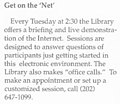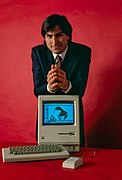Portal:Internet
The Internet PortalSelected article
An HTTP cookie is a parcel of textual information sent by a server to a World Wide Web browser and then sent back by the browser each time it accesses that server. HTTP cookies are used for user authentication, user tracking, and maintaining user-specific information such as site preferences and electronic shopping carts. Cookies have been of concern for Internet privacy, since they can be used for tracking the browsing of a user. As a result, they have been subject to legislation in various countries such as the United States, as well as the European Union. Cookies have also been criticised because the identification of users they provide is not always accurate and because they can be used for network attacks. Some alternatives to cookies exist, but have their own drawbacks. On the other hand, cookies have been subject to a number of misconceptions, mostly based on the erroneous notion that they are computer programs. Most modern browsers allow users to decide whether to accept cookies, but rejection makes some Web sites unusable.
Selected picture Metropolitan area networks, or MANs, are large computer networks usually spanning a city. They typically use wireless infrastructure or Optical fiber connections to link their sites. News
Wikinews Internet portal
WikiProjects
Did you know (auto-generated) -
Selected biography
Douglas C. Engelbart (born January 30, 1925 in Oregon) is an American inventor of Swedish and Norwegian descent. As a World War II naval radio technician based in the Philippines, Engelbart was inspired by Vannevar Bush's article "As We May Think". Engelbart received a Bachelor's degree in electrical engineering from Oregon State University in 1948, a B.Eng. from UC Berkeley in 1952, and a Ph.D. in EECS from UC Berkeley in 1955. At Stanford Research Institute , Engelbart was the primary force behind the design and development of the On-Line System, or NLS. He and his team at the Augmentation Research Center developed computer-interface elements such as bit-mapped screens, groupware, hypertext and precursors to the graphical user interface. In 1967, Engelbart applied for and later received a patent for the wooden shell with two metal wheels (computer mouse). Engelbart later revealed that it was nicknamed the "mouse" because the tail came out the end. He would also work on the ARPANET, the precursor of the Internet. In later years he moved to the private firm Tymshare after SRI was transferred to the company. McDonnell Douglas took over the copany in 1982, and in 1986 he left the company. As of 2007, he is the director of his own company, the Bootstrap Institute, which founded in 1988 and located in Fremont, California.
General images -The following are images from various internet-related articles on Wikipedia.
Selected quoteMore Did you know...
Main topics
Featured contentCategoriesRelated portalsThings you can do
Associated WikimediaThe following Wikimedia Foundation sister projects provide more on this subject:
Wikipedia's portals |






















































